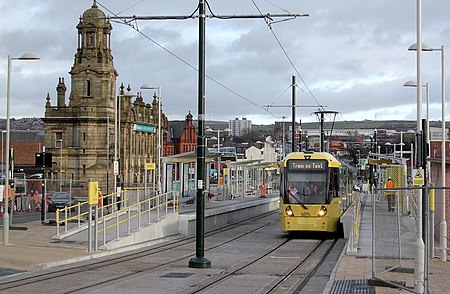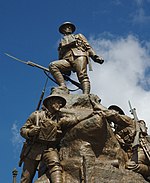Oldham Mumps tram stop

Oldham Mumps is a tram stop on the Oldham and Rochdale Line (ORL) of Greater Manchester's light-rail Metrolink system in the Mumps area of Oldham which opened in 2014. A temporary stop of the same name opened to passengers on 13 June 2012 as part of Phase 3a of the system's expansion. Phase 3b resulted in the stop's decommissioning in 2014, and its replacement with the permanent stop at the opposite end of Mumps on a realigned track. The temporary stop was on the site of the original Oldham Mumps railway station, a heavy rail station which opened (initially for haulage) on 1 November 1847 and closed on 3 October 2009 for conversion to Metrolink. It was along the Oldham Loop Line, which operated from Manchester to Rochdale via Oldham and thus was almost identical to the current Metrolink route.
Excerpt from the Wikipedia article Oldham Mumps tram stop (License: CC BY-SA 3.0, Authors, Images).Oldham Mumps tram stop
Roscoe Street,
Geographical coordinates (GPS) Address Nearby Places Show on map
Geographical coordinates (GPS)
| Latitude | Longitude |
|---|---|
| N 53.54241 ° | E -2.10342 ° |
Address
Oldham Mumps
Roscoe Street
OL1 3TL , Mumps
England, United Kingdom
Open on Google Maps





